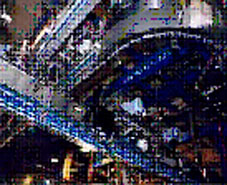An integrated process engineering system helps Pepsi Russia increases output for soft drinks in PET
AS one of the largest beverage operations in Russia, Pepsi Bottling Group currently operates five plants in Moscow, St. Petersburg, Samara, Yekaterinburg, and Novosibirsk. In Yekaterinburg, a new system consisting of sugar treatment, the syrup room, the water treatment plant, and the media and energy supply as well as a new PET line designed for an output of 60,000 0.6-liter or 45,000 1.25-liter PET bottles per hour, is fulfillment of plans first set out nearly 15 years ago. In 1994, the Russian market along with those in India, China, and Brazil markets were defined as a future growth markets for Pepsi brands "The current investment locations for Russia were specified at the time," said Rajendra Gursahaney, worldwide senior engineering director at Pepsi Bottling Group. Pepsi brand remains popular While Pepsi Russia produces around 35 different products, the popularity of the original Pepsi brand remains undiminished. Today, Pepsi-Cola, Pepsi Light, Pepsi Twist, Pepsi Lemon, Pepsi X, and Wild Cherry Pepsi chalk up approximately 30% of total sales. The second most popular brand is Aqua Minerale (carbonated, still, and flavored) with around 25%, followed by Lipton iced tea varieties with a share of 17%. The group is also a major shareholder in leading Russian juice producer Lebedjanski.  Without taking into account Lebedjanski sales figures, with a 20.5% share in the Russian soft drinks market the Pepsi Bottling Group ranks just behind Coca-Cola. Taking fruit juice sales into account, Pepsi becomes the largest soft drinks producer in Russia. During the economic crisis in Russia in 1998, Pepsi only sold nine million "raw cases" (Pepsi jargon for a quantity equivalent to about 12 liters). By 2000, Pepsi Bottling Group sales in the Russian market had already reached 13 million raw cases. By 2002, sales figures had increased to 35 million raw cases. By 2007 ?believe it or not ?sales had increased 105 millions raw cases. For 2008, the Pepsi Bottling Group expected Russian market sales to reach around 115 millions raw cases. All from one source Pepsi Bottling Group intentionally decided in favor of the integrated KHS process engineering concept in order to avoid interface problems. In constant cooperation with the Pepsi management and local Pepsi employees, KHS basically organized everything. The integrated system starts in the syrup room with the sugar treatment using a dissolver and sugar pasteurizer, followed by storage of the liquid sugar and a batchmix system as well as mixing tanks. The two-component Innopro PARAMIX CMX mixer then handles the task of continuously producing carbonated Pepsi brand products and integrates the water and syrup component deaeration, dosing, and mixing processing steps, and subsequent carbonation in a single unit. First, the water is degassed using a two-stage vacuum spray method. Syrup is then continuously added to water inline, exactly controlled by precise flowmetering of both media according to the ratio of ingredients specified in the recipe. The carbonation process, likewise inline, takes place under constant pressure, and guarantees gentle, no-foam saturation. Exact compliance of the Brix and CO2 values with the product specification for the Pepsi brand products ensured by the implemented measuring instrumentation. With the KHS line equipment recently put into operation, the Yekaterinburg plant produces around 20% of the Pepsi products sold in the Russian market and covers the demand in the region. The PET hot fill line soon to be commissioned will enable Pepsi to process Lipton iced tea at Yekaterinburg. "This project not only turned into one of our best projects in Russia to date," said Gursahaney, "it is also one of our most successfuNike Kyrie 5
Without taking into account Lebedjanski sales figures, with a 20.5% share in the Russian soft drinks market the Pepsi Bottling Group ranks just behind Coca-Cola. Taking fruit juice sales into account, Pepsi becomes the largest soft drinks producer in Russia. During the economic crisis in Russia in 1998, Pepsi only sold nine million "raw cases" (Pepsi jargon for a quantity equivalent to about 12 liters). By 2000, Pepsi Bottling Group sales in the Russian market had already reached 13 million raw cases. By 2002, sales figures had increased to 35 million raw cases. By 2007 ?believe it or not ?sales had increased 105 millions raw cases. For 2008, the Pepsi Bottling Group expected Russian market sales to reach around 115 millions raw cases. All from one source Pepsi Bottling Group intentionally decided in favor of the integrated KHS process engineering concept in order to avoid interface problems. In constant cooperation with the Pepsi management and local Pepsi employees, KHS basically organized everything. The integrated system starts in the syrup room with the sugar treatment using a dissolver and sugar pasteurizer, followed by storage of the liquid sugar and a batchmix system as well as mixing tanks. The two-component Innopro PARAMIX CMX mixer then handles the task of continuously producing carbonated Pepsi brand products and integrates the water and syrup component deaeration, dosing, and mixing processing steps, and subsequent carbonation in a single unit. First, the water is degassed using a two-stage vacuum spray method. Syrup is then continuously added to water inline, exactly controlled by precise flowmetering of both media according to the ratio of ingredients specified in the recipe. The carbonation process, likewise inline, takes place under constant pressure, and guarantees gentle, no-foam saturation. Exact compliance of the Brix and CO2 values with the product specification for the Pepsi brand products ensured by the implemented measuring instrumentation. With the KHS line equipment recently put into operation, the Yekaterinburg plant produces around 20% of the Pepsi products sold in the Russian market and covers the demand in the region. The PET hot fill line soon to be commissioned will enable Pepsi to process Lipton iced tea at Yekaterinburg. "This project not only turned into one of our best projects in Russia to date," said Gursahaney, "it is also one of our most successfuNike Kyrie 5













